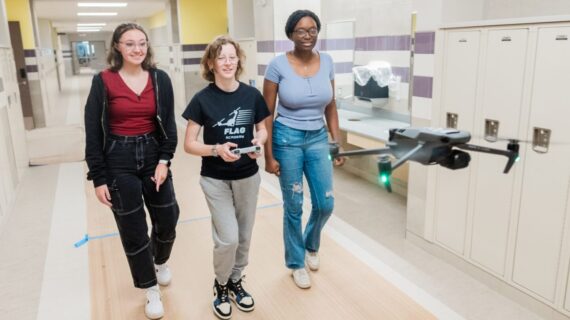
In the Hollidaysburg Area School District, Golden Tigers give back
This story is one in a series created in collaboration with the AASA Learning 2025 Alliance to celebrate the work of groundbreaking school districts in the Pittsburgh region. Kidsburgh will share these stories throughout 2024.
The parking lot should have been empty.
It was Sunday afternoon, and Principal Maureen Letcher had arrived for a small volunteer event at Hollidaysburg Area Senior High School. But instead of an empty lot, there were so many cars that Letcher had trouble finding a spot. “There were people everywhere,” she says. “I figured there must have been something else going on — some other event I didn’t know about.”
Then she saw the cafeteria.
It seemed like half the school had shown up. The students, like Letcher, had come to volunteer. They formed assembly lines in the cafeteria, packing bags with protein and carbs, weighing them, and preparing them for shipping with Rise Against Hunger, a nationally known nonprofit.
”It was unbelievable,” says Letcher, beaming at the memory. “We packed 10,000 bags of food that day.”
The event marked a special moment for the Hollidaysburg Area School District. In the months that preceded it, the district had convened the whole community to create the “Portrait of a Golden Tiger,” a map of competencies essential to students’ success. With input from parents, teachers, business owners, and students themselves, the community had named six essential Golden Tiger traits — the first of which was citizenship.
And here, in the high school cafeteria on a Sunday afternoon, was citizenship come to life.

Other competencies would follow, with the district introducing a new one every few weeks: adaptability, integrity, analytical thinking, perseverance, and communication. Whenever the district rolls out a new trait, “We always kick it off with some kind of activity,” explains Adam Walstrom, the high school’s assistant principal. “Sometimes, it’s an event, like the one we did with Rise Against Hunger. Other times, it’s a game. But the goal is always to get students engaging with [the competencies]. It’s to show them, ‘Hey, this is what we want you to learn and know and be good at by the time you leave Hollidaysburg Area. And here’s why it matters.’”
The six Golden Tiger competencies are also tied to instruction, ensuring that students graduate with the skills and knowledge that their community needs most. Each academic department “owns” a given competency, designing its rollout and related activities. (English teachers, for example, take the lead on teaching communication.) But each competency comes up in other classes, too, creating a district-wide focus that crosses departments, grade levels, and schools.
This commitment to students’ futures led the Hollidaysburg Area School District to join the Western Pennsylvania Learning 2025 Alliance, a regional cohort of school districts working together — with support from The Grable Foundation — to create student-centered, equity-focused, future-driven schools. Led by local superintendents and AASA, The School Superintendents Association, the Alliance convenes to help districts like Hollidaysburg Area do what they do best: prepare every learner for tomorrow.

The district’s high school, for instance, is moving toward a blended-learning model that combines traditional classroom learning with online courses, college-level lectures, and asynchronous digital tools. The added flexibility of such a model not only better reflects the working world that students will one day encounter, but also allows the district to incorporate wellness activities, special events, and other opportunities for learning and student leadership.
For example: “Our Point-and-Needle Club has really taken off,” Walstrom explains. What began as a way to give students a break from the school day, has since become a valuable tool for learning. Led by a student who teaches crochet in the library, the club makes things like water bottle covers and winter hats. And while “You don’t typically think of high school students as wanting to crochet,” says Walstrom, “students are asking to take their projects home and keep working on them.” It’s also helping them in class: students in the club say moving their hands helps keep anxiety and stress at bay.
To Letcher, the club is another expression of the Portrait of a Golden Tiger — an engaging, enjoyable way to bring essential competencies to life. Through crocheting, students learn perseverance and adaptability. They learn citizenship by crocheting hats for people in need.
“Ultimately,” she says, “that’s what we want: students who can take their knowledge and their skills and put them to use for good. A Golden Tiger is someone who gives back — to their school community, to their work community, to wherever they happen to be. We’re big believers in that. And that’s what all of us here at Hollidaysburg Area are working together to teach.”
Want to download this story? Click here for a PDF.













